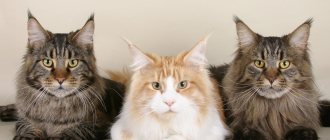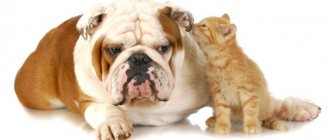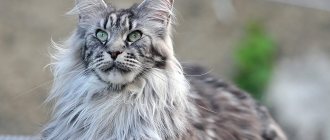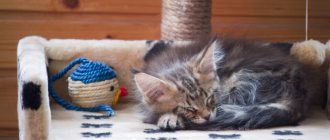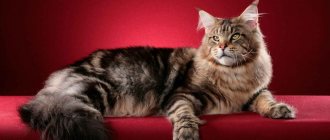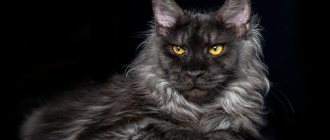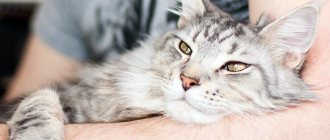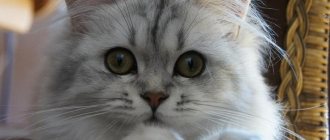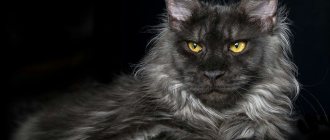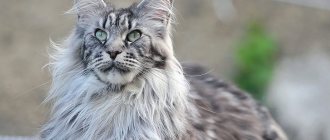Large sizes, tufts on the tips of the ears and other striking differences from other cats have given rise to many legends and myths about the appearance of Maine coon seals.
There are several assumptions related to the history of the origin of the Maine Coon breed - there are both romantic variations, largely based on the appearance of the animals, and scientific theories put forward by zoologists.
The future owner is recommended to first learn as much as possible about the pet - where the name of the breed came from, how Maine Coons developed not only in Europe, but also in Russia.
History of the name
Maine Coon literally means "Maine Raccoon". The ancestors of this breed provided themselves with food by hunting small birds, mice and rats.
The rats ate farmers' grain reserves, so they began to tame cats - they, in turn, lived with people and went for walks in the forest. Over time, pets became more and more domesticated - they did not need special care and did not cause unnecessary trouble to people.
Character
The Maine Coon will have the same character as its owner. These cats, growing up, carefully observe their owner, adopting his habits and behavior. Despite its size, the Maine Coon shows almost no aggression. He gets along well with both people and other animals.
These cats love to play, but can also lie with their owners for a long time and watch their favorite TV series with them. The Maine Coon is not vindictive, unlike many other breeds, and will not think of revenge in the form of torn furniture if he is yelled at. The Maine Coon is easy to train. He can learn to open doors and use the toilet.
The Maine Coon differs from other cats in its love of water. He can play with water, wash food in it, picking it up on his claws, splash and swim with pleasure.
Legends about the origin of Maine Coons
The state of Maine in America is considered to be the place of origin of Maine Coon cats, but the variants of their appearance are strikingly different from each other.
Marriage between a cat and a raccoon or lynx
The essence of this myth is that cats brought to America from Asia crossed with raccoons. Proponents of this theory cite the color of the Maine Coon's coat and the appearance of its tail as evidence.
No less popular is the legend about the connection between a lynx and a cat, which led to the appearance of Maine Coons - it arose due to the characteristic tufts on the pets' ears.
In turn, from a genetic point of view, such unions cannot exist, since animals of these species differ in the set of chromosomes.
Cat on a ship
There are several sea stories about the appearance of Maine Coons:
- One of them tells the story of Captain Kun, nicknamed “Raccoon” by the sailors. He went on his voyages with his favorite pets - a cat and cats, distinguished by their large size and long fur. On the ship they ate mice, thereby protecting the crew's supplies from spoilage. After each call to the port, the animals gave birth to offspring, and Kun gave some of the grown kittens to his friends.
- Another version of the story of the original origin of cats of this breed is based on the fact that “Raccoon” distributed kittens to residents of Maine. Growing up, they created alliances with American cats and female cats, which was the reason for the appearance of the Maine Coon representatives.
- The third myth is that Scandinavian sailors took cats on board their ships to hunt rats. They chose hardy, large-sized specimens accustomed to difficult living conditions. In ports, animals came onto land and mated with local cats.
- There is also an opinion that cabin boy Tom Coon sold kittens in Maine that were born on the ship during the voyage - they became the first representatives of the Maine Coon breed.
There is a legend that the ancestors of these cats are animals that survived before the destruction of Atlantis. One of these cats ended up in Russia and became the ancestor of Siberian seals. Another led to the appearance of representatives of the Norwegian breed, and the third led directly to the Maine Coons.
Connection with the Queen
There is another popular legend - Marie Antoinette made every effort to escape from the prison in which she was put by the revolutionaries. She ordered all her property to be loaded onto the ships and sent towards America. Among the riches were the royal favorites - large fluffy cats.
The queen never escaped, but the loaded ships arrived in America, where the pets crossed with local cats, resulting in the Maine Coon.
Viking deity
The Vikings deified the image of a cat, associating it with Freya, the goddess of war, fertility, beauty and love. Even before Columbus, they visited America more than once, and the ancestors of modern Maine Coons were always present on their ships.
There is an opinion that these were large Norwegian cats with thick hair - they left the ship without permission and mated with local cats, this was the reason for the appearance of the original breed.
This theory is considered the most plausible, since genetic tests have confirmed the similarities between the Norwegian cat and Maine Coons, but scientists do not agree with any of the above myths.
Care
All large breed animals have the same problem - the condition of the bones and joints. To prevent your Maine Coon from experiencing such troubles, he must receive vitamin supplements with calcium and potassium and have regular exercise.
Since this breed is long-haired, the cat needs to be given a paste that cleanses the stomach of hairballs. You need to brush your cat a couple of times a week.
Otherwise, caring for a Maine Coon is the same as for regular cats. Regular vaccinations, parasite removal, ear and eye cleaning are required.
True origin story
There are several ways to breed a new breed of animal:
- naturally;
- through artificial crossing.
From the point of view of biologists, Maine Coons appeared as a result of natural evolution, namely, they descended from their American ancestors, without human intervention. Their distinctive external features arose as a result of the harsh climate of their place of residence.
Interesting! Over time, the ancestors of the breed adapted to the living conditions - their thick and long hair protected them from the cold, their long paws allowed them to move through the snow without much difficulty, and they rested on their bushy tail.
Kinds
The breed is considered native and one of the oldest in North America. But breeders from Europe created new lines, leaving a recognizable appearance, but assigning new features to the cats. This is how two intrabreed lines appeared - American and European.
- American Coons have a strong and strong bone structure; they are slightly lower than their European relatives, but are not inferior to them in weight and power. Americans have a wide head; the transition from the convex forehead to the muzzle is more noticeable. The eyes are round. The ears are shorter and wider apart than those of Europeans, and lush “lynx” tassels are not adopted. Outwardly, they are more similar to the Norwegian forest or Siberian breed.
- The European type was formed in the 90s of the last century. An important difference is slightly slanted and squinted eyes. It was these individuals who became famous for their slightly predatory and contemptuous gaze due to the unusual shape of their eyes. Their muzzle appears triangular, the body is often elongated, the tail is long, along the back it should reach the shoulder. The paws are high.
Further history of development
In America
Chronology of Maine Coon breeding in the United States of America:
- For the first time, Maine Coons participated in an exhibition in 1861 in New York, and felinologists registered the first record in 1908. A cat named Captain Jenks was exhibited, which delighted all the spectators.
- In 1878, 10 pets of this breed were presented at the exhibition.
- In the 1930–1940s, the fame of this breed faded and Persian cats came to the fore.
- In 1980, there were more than one thousand Maine Coon owners in the country.
Today in America the Maine Coon is the third most common breed.
In Europe
The first representative of the breed appeared in France in 1981, and his name was Charlie. A few years later, Maine Coons were brought to England. In 1993, a souvenir coin with the image of a pet appeared in the UK.
Selection today
Now all over the world, incl. and in Russia, the Maine Coon cat breed ranks first in the ratings. Numerous nurseries are engaged in artificial breeding of cats of this breed and are working to improve the breed through artificial selection and crossing.
Previously, only the black marbled color of the animal was recognized. Now any options are allowed.
European felinologists understand the importance of American roots when breeding Maine Coons, and therefore value cats brought from their historical homeland.
Interest in Maine Coons periodically increased and fell again, because... new breeds appeared. But this species is not giving up its position. Now he is again among the most recognized. These cats participate in international exhibitions of world significance and receive high awards.
Diet preparation
According to all the rules, the breeder should help you create a competent table for the cat of your dreams. At the stage of purchase (if not earlier), the seller is obliged to advise you about the nutritional features of the kuna, recommend the optimal menu, consisting of 90% “natural” - that is, meat, cereals, fermented milk products and a small amount of boiled, ground with meat or vegetable porridge, and 10% premium dry food (needed for brushing teeth).
Please note: improper nutrition is fraught with a host of health problems, including the formation of mats or hair loss, the development of urolithiasis (UKD) or behavioral disorders in the animal.
Description of the breed
Animals of this breed are large in size; cats are much larger than cats. The average weight is from 8 to 10 kilograms. There are specimens weighing 12 kg. The body length from the nose to the tip of the tail is about 130 centimeters, with half the size being a luxurious, fluffy tail. The height of the paws is 40-42 cm. However, with such sizes, cats do not look massive and clumsy; they have a large head, a wide chest and a muscular body. These are born hunters.
Maine Coon wool has an interesting property - it is almost impervious to moisture and does not get wet. Moreover, it has different lengths: there is a chic “collar” on the neck, the hind limbs are dressed in “fur pants”, there is thick fur with undercoat on the back, sides and belly, and the head and paws are covered with shorter hair. The shape of the paws resembles snowshoes - they are wide and powerful, with hairs growing between the toes.
This breed has interesting, unique ears - large, located high on the head, with thick skin, covered inside with fur, and outside with dense hair. At the very tips there are tassels, like a lynx. All of these properties helped these cats survive and get food in the harsh places where they came from. The officially recognized homeland of Maine Coons is Maine, United States of America. Farmers specially bred cats to combat rodents that spoiled grain.
It is believed that animals began to be actively domesticated approximately 150-200 years ago. As in any other business, competition and excitement arose between people. Everyone wanted their cat to be bigger than the one on the neighboring farm. Therefore, only the most outstanding individuals were left for the tribe. Thus, the breed was gradually formed. Despite their rather impressive size, cats have a calm, balanced character. They are not aggressive and are trainable. They become attached to their owners and get along well with children.
Difficulties and possible illnesses
The breed is hardy and has good health, but cases of illness still sometimes occur. Among the most common diseases is hypertrophic cardiomyopathy.
Spinal muscular atrophy is also among the most common. This disease is hereditary, so the cat’s parents and their health are an important factor when buying a pet. This disease is incurable, it leads to muscle weakness and complete atrophy. Hip dysplasia is also a hereditary disease. It is characterized by severe pain and even lameness of the animal. The disease is not fatal, but it often causes osteoarthritis. To avoid these and other diseases, take your Maine Coon to the veterinarian periodically. He must monitor the health of the animal, then you will not have to worry about the well-being of your pet.
The main rule of keeping a cat is love and respect for him. Before you decide to get yourself a four-legged friend, make sure you are ready to take on this responsibility.
pets2.me
